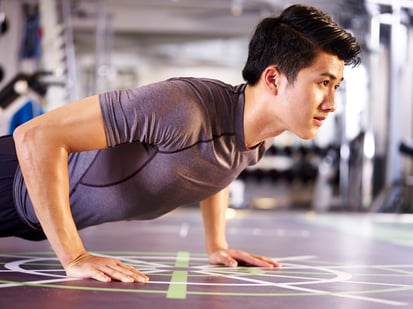 In my previous blogs I discussed the four movement patterns that all training fits into. I then went on to talk about scheduling a training plan using the four movement patterns. In this post I will discuss one of the more popular patterns: the pushing movement pattern.
In my previous blogs I discussed the four movement patterns that all training fits into. I then went on to talk about scheduling a training plan using the four movement patterns. In this post I will discuss one of the more popular patterns: the pushing movement pattern.
What the Pushing Movement Pattern Does
The first thing we must discuss is what muscles the pushing pattern works and why we should incorporate it into your training plan. This movement pattern works the muscles of the chest, shoulders, and triceps. These muscles are all responsible for pushing objects away with your upper body. These muscle groups are the primary movers for activities of daily living: lifting items over your head, holding your kids, or pushing other shoppers out of the way on Black Friday.
Training the pattern instead of individual muscle groups is useful because of time efficiency. For gym-goers who don’t have two hours to spend at the gym seven days per week, it doesn’t make sense to train one muscle group per day. That would not be the best use of your time. Training one to two movement patterns will ensure that you hit multiple muscle groups with fewer exercises. The reason for this is that correctly chosen exercises can work multiple muscle groups at the same time.
Exercises for Pushing Movements
The following exercises, organized by muscle group, help you work the pushing movement pattern.
Chest
- Pushups
- Bench Press
- Incline Bench Press
- Decline Bench Press
- Dumbbell Variation of all the movements
- Machine Variations of all the movements
- Pec Fly
Shoulders
- Barbell, Dumbbell, or Kettlebell Overhead Press
- Military Press
- Push Press
- Olympic Push and Split Jerk
- Arnolds Press
- Machine Overhead Press
- Lateral and Frontal Raises
- Rear Delt Fly
Triceps
- Close Grip Bench
- Skull Crushers
- Dumbbell Kickbacks
- Triceps Extension
- Dips (bench, assisted, and bodyweight)
- JM Press
Movements That Work More Than One Muscle Group
As I stated before, there is also some overlap in muscle groups with some movements. Unless it is a complete isolation move, there will be some muscle recruitment across the whole upper body. For example, the barbell bench press is primarily a chest movement; however, the lockout of the arms is dominated by the triceps. The role of the chest is to push the bar off the chest, but once it reaches a certain height, the triceps take over. The same can be said for any overhead pressing as well. This is what makes training within muscle groups so time efficient. Isolation movements are best left for the end of the workout.
For more information on how to properly progress and structure a training program, visit us at the track desk to set up a session. We are more than happy to help at any time, and as a part of your membership here at NIFS, you can receive as many free workout programs as you would like. Our health fitness professionals tailor all programs to your fitness goals.
This blog was written by Evan James, NIFS Exercise Physiologist EP-C, Health Fitness Instructor, and Personal Trainer. To learn more about the NIFS bloggers, click here.

